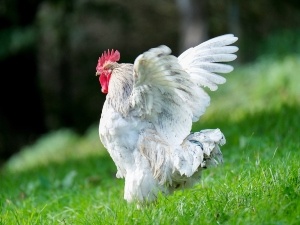
Chickens are generally very healthy animals. These birds can go months and even years without getting ill. But, just as with any other animal, chickens can get ill as well.
If there are red spots on your chicken’s legs you may be concerned and you should be, this article explores why your chicken has red spots on its legs
The red spots on your chicken’s legs may be perfectly normal skin discoloration on the legs, or they may be parasites or pox
Table of Contents
Red spots on chicken legs, why this happens, what to do
Normal skin discoloration:
If your bird is a rooster, then seeing a line of red spots on the bird’s legs (along the shank) is completely normal. That is, if the spots are flat, and are simply a section of the bird’s skin that just happens to be red in color.
Also, don’t worry if the red spots appear redder and brighter when the bird is working and verile
If the spots are raised or have a different texture to your bird’s legs, then this is cause for concern.
What to do:
You don’t have to do anything in this case, this is completely normal for these birds.
Parasitic infections:
Parasites such as lice, mites, fleas, and ticks simply love chickens. These little critters will hide in the nooks and crannies of your coop and will come out at night and climb onto your chicken to feed.
This lifestyle makes it difficult for chicken farmers to find these parasites, if they don’t know where to look. If you look closely at your bird, the red spots on their bodies can actually be parasites, these parasites can also look black or brown
What to do:
Using poultry dust (permethrin) on your bird, and in their coop, is recommended. Permethrin is frequently used to treat and get rid of lice and mites in humans, it can be used for chickens as well.
This powder can be used in your hen houses, nest boxes, and coops when trying to get rid of parasites where your birds live. It can also be used directly on chickens as it has low levels of toxicity to animals and humans, but is deadly to parasites.
Ivermectin is commonly used on chickens to treat this condition but it isn’t recommended because it is not approved for use on chickens.
Pox
If you have mosquitoes in the area, and your birds are starting to develop red spots on their legs, wattles, face, or neck, then your bird likely has pox. This is a viral disease that mosquitoes can transfer to chickens.
The red sores or pimples are what you’ll see first, over time, these sores will fill with fluid. After some time, these sores will fill with pus, and then finally, the pimples will burst open. Your bird will be left with scabs and crusts after the sores pop.
What to do:
Cleaning and sanitizing the area is a must, use oxine to clean and sanitize your chicken’s coop weekly for about a month, add oxine to the birds drinking water as well. Make sure to also clean and sanitize the waterer daily.
There is no cure for pox but you can add tetracycline antibiotics to your chicken’s water sources to help control any secondary infections that may develop. Using an iodine solution on your bird’s scabs will also be helpful.
If you can, you’d need to control the mosquitoes in the area. Also, try to avoid bringing this disease to your healthy flock through contamination through your equipment, shoes, and clothes after coming into contact with infected birds from another flock.
Your future birds should be vaccinated against this illness.
Conclusion
In conclusion, if the spots on your bird’s legs are flat then you have nothing to worry about, this is normal. A closer look at the birds may reveal that the spots are actually one or another type of parasite.
If the spots initially look like sores, then turn into pus-filled lesions, then your birds may have pox.
If you enjoyed this article then you may also be interested in other chicken related articles. Here are some articles that you may be interested in: Baby Chick With Swollen Bottom, Chicken Has Dry Flaky Skin, Red Inflamed Skin On Chickens, Chicken Dandruff

